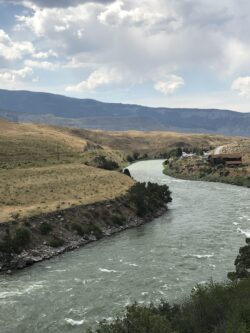The Yellowstone River begins in Yellowstone Park and flows free until it merges with the Missouri and Mississippi River downstream. It is the longest, undammed watershed in north America and Montana. Free flowing rivers are wonderful until we consider what fish migration may occur.
We have all seen the videos of the jumping carp in the Mississippi River, snakeheads crawling from watershed to watershed, and the other invasive species that make alien watersheds their new homes. When this happens, native fish species are often impacted in a negative way.
On February 19th, an angler caught a smallmouth bass near Gardiner Montana. This is the first documented bass catch in this area. It was caught near where the Gardiner River flows into the Yellowstone River. Unfortunately, the angler did not kill the invasive fish, and threw it back.
This is the 3rd catch of a smallmouth bass in the area in the last 7 years. The bass could have been illegally transferred by someone or escaped from a private watershed or pond. It is true that smallmouth bass are in the lower Yellowstone River, but there are virtually no reported catches between Gardiner and well east of Livingston. Any transfer of fish without approval from the FWP is against the law. There have also been reports of catching smallmouth bass in a reservoir of the upper Shields River, a tributary to the Yellowstone.
Small mouth Bass are common in the lower reaches of the Yellowstone River. Their migration upstream has been blocked by cold water. Recently, the water temperatures of the Yellowstone watershed have increased. Climate change has also caused water temps to become more inviting to warm water species, such as smallmouth bass.
To a bass fisherman, this may seem like great news. Smallmouth bass are a great sportfish and are also wonderful to eat. In a trout ecosystem, they are an apex predator. The evolutionarily older Cutthroat trout are vulnerable to being eaten by these aggressive bass.
Yellowstone Lake has also been contaminated with an invasive, non-native fish. Lake trout and now ciscoes have been introduced by anglers that used bucket biology to change the ecosystem to their liking. It has taken decades and millions of dollars to finally get some control of the lake trout invaders and save the native cutthroats.
Invasive species are no joke. Like it or not, certain species evolved to live in certain ecosystems. These balanced and complex habitats include natural predators, prey, and relationships designed to maintain a healthy and balanced ecosystem.
The USGS will be sampling the area in the next few weeks to see if more smallmouth bass are in the area. Any caught bass will be removed from the threatened fishery.
Unwanted invasive species means a disruption and unwanted change to our historically natural ecosystems. If you catch an invasive species, such as a bass, document it and kill the fish. Notify the FWP of your catch. A cell phone picture is a good idea. Bass are delicious, just saying.
Nature knows best!
Montana Grant